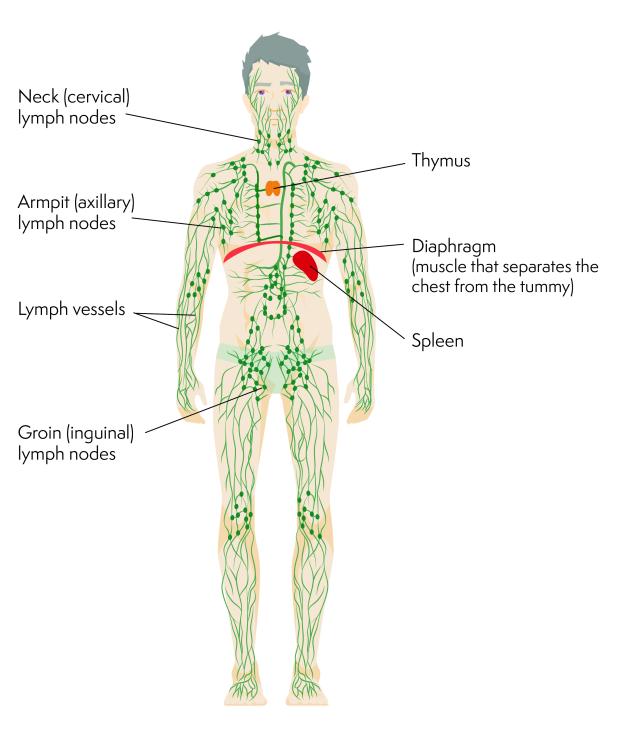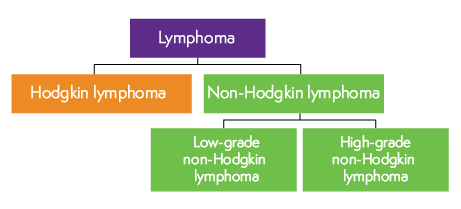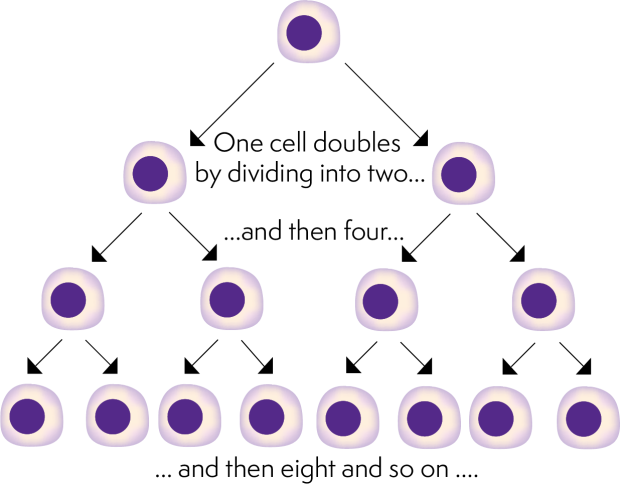What is lymphoma?
Lymphoma is a type of cancer. This information explains what lymphoma is and how cancer develops. We have separate information about the possible causes and risk factors of lymphoma.
On this page
 What is lymphoma?
What is lymphoma?
Lymphoma is a type of blood cancer.
- It is the 5th most common type of cancer in the UK.
- It can affect both adults and children, at any age.
- There are effective treatments for most types of lymphoma.
Watch our animation explaining what lymphoma is, how it develops and treatments available.
This animation has been translated in Polish, Punjabi and Romanian.
- Support our Let’s talk lymphoma campaign this September to make more people aware of the signs of lymphoma.
Lymphoma develops when white blood cells called lymphocytes grow out of control. Lymphocytes are part of your immune system, which helps to fight infection. Lymphocytes travel around your body in the lymphatic system carrying a fluid called lymph. The lymph fluid passes through glands (lymph nodes), which are spread throughout your body. For this reason, lymphoma might also be referred to as a cancer of the immune system.

If you have lymphoma, your lymphocytes divide in an abnormal way or do not die when they should. The abnormal lymphocytes build up, usually in lymph nodes in your armpits, neck or groin. However, they can collect in almost any part of your body.
The symptoms of lymphoma depend on where the lymphoma starts, what parts of your body it affects, and what type of lymphoma it is. There are over 60 different types, broadly grouped into Hodgkin lymphomas and non-Hodgkin lymphomas. Non-Hodgkin lymphomas are further grouped depending on whether they are slow-growing (described as ‘low-grade’ or ‘indolent’) or fast-growing (‘high-grade’ or ‘aggressive’). Different types of lymphoma behave differently and need different treatment.

 Other types of blood cancer
Other types of blood cancer
Lymphoma, leukaemia and myeloma are all types of blood cancer (also known as ‘haematological’ cancers). Although there are similarities between some types of lymphoma and leukaemia, most types develop differently. They also behave differently and are treated differently.
If you would like information or support in relation to other types of blood cancers, you might be interested in our useful organisations listing, which includes blood cancer organisations.

 How cancer develops
How cancer develops
We start life as a single cell. You might think of this as a tiny building block. While in the womb, this cell splits into two cells, then four cells, then eight cells, and so on.

As the cells continue to divide, they gradually develop into all the different types of cell we’re made of, such as blood cells, muscle cells and nerve cells. By the time we’re born, our bodies contain trillions of cells of about 200 different types. After we’re born, these cells carry on dividing – this allows us to grow and develop.
Some cells continue to divide throughout the lifespan. This process replaces old cells that die off naturally. Different types of cell divide at different speeds, and have different lifespans. Each day, millions of our cells die and are replaced by new ones.
Abnormal cell division and cancer
Cell division and cell death are normal, healthy processes. They are controlled by chemical signals. Usually, cell division and cell death are in careful balance, so that we make only the number of new cells our body needs.
Watch Professor Andy Davies talk about what lymphoma is and how it develops
Throughout life, changes (mutations) happen to our DNA (genetic material). Most of the time, these changes are harmless. However, they can sometimes disrupt vital processes within our cells. This can create abnormal cells that stop responding to control signals. These cells might:
- start dividing when they shouldn’t
- carry on dividing when they should stop
- stay alive when they should die.
When this happens, a group of cells can form that divide faster than they die, leading to a build-up of abnormal cells (cancer). It usually takes a number of different mutations for a cancer to develop.
In order for cancer to develop, the abnormal cells:
- need to divide and grow uncontrollably
- avoid (or ‘hide from’) the body’s immune system
- get all the nutrients they need to survive.
Once cancer develops, the abnormal cells might stop your body from making normal, healthy cells. This can prevent organs in your body from working properly. The abnormal cells might spread to other parts of the body and start growing there too. Cancer also uses up the energy and nutrients your body needs.
There are a lot of different types of cancer depending on what type of cell has become abnormal. Different types of cancer can cause different symptoms and effects, depending on where the cancer is and how fast it is growing.
In this video Dr Rob Lown gives an overview of lymphoma
Information and support
If you, or someone you know, has been diagnosed with lymphoma, we're here for you. We have a range of support services and information you can trust.
